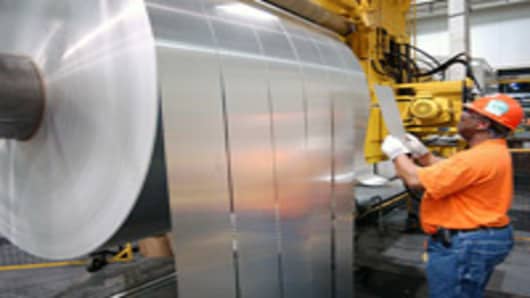U.S. factory activity shrank less than expected in March, while construction spending fell again in February as home building tumbled for a record 24th straight month.
The Institute for Supply Management said its index of national factory activity edged up to 48.6 in March from 48.3 in February, but was still below the level of 50 which separates growth from contraction.
It was the third time in four months the gauge has shown contraction.
Meanwhile, the survey's measure of inflation jumped to its highest since the immediate aftermath of Hurricane Katrina in 2005, when energy prices soared.
"The ISM manufacturing index gave a choppy sideways picture of manufacturing which is better than might have been feared but doesn't give conclusive indication whether export strength will sustain overall activity in the face of domestic spending," said Pierre Ellis, senior economist at Decision Economics in New York.
"That kind of offset is critical to keep the recession relatively mild." Wall Street cheered the report, however, since the reading on manufacturing was higher than the 47.5 foreseen in a Reuters poll of economists.
Stocks rose and the dollar also extended its gains versus the euro and yen after the ISM data.
Prices on government bonds, which are generally hurt by inflation and economic strength, fell to the session's lows.
The signs of worsening inflation came from the ISM's prices paid index, which jumped to 83.5 in March -- its highest since October 2005 -- from 75.5 in February.
The manufacturing employment index rose to 49.2 in March from 46.0 in February.
The new orders index slipped to 46.5 in March from 49.1 in February.
Meanwhile, the Commerce Department reported that overall construction activity dropped 0.3 percent in February, reflecting weakness not only in home building but also in nonresidential activity. Only government building projects showed a gain in February.
Residential construction fell by 0.9 percent in February. Residential activity has fallen every month since March 2006, a record period of declines that underscored the severe downturn going on in housing.
Analysts believe that housing will keep falling until a record glut of unsold homes is reduced. That effort is being hindered by the fact that mortgage defaults have soared to record levels, reflecting the abuses that occurred in lending activity at the height of the housing boom.
The weakness in housing is combining with soaring energy prices and a severe credit crunch to push the economy close to a recession.
The Bush administration is hoping that an economic stimulus package will boost growth starting this summer, when 130 million households begin spending their rebate checks.
The 0.3 percent drop in construction spending represented the fifth straight decline in overall activity. Spending had fallen by 1 percent in January and 1.7 percent in December.
In addition to the continued fall in housing construction, spending on nonresidential projects dropped by 0.1 percent in February after declines of 1 percent in January and 0.2 percent in December. Weakness in February reflected declines in office building, health care facilities and schools.
Government spending was the one area of strength, rising by 0.4 percent with federal spending surging by 1.4 percent and state and local projects rising by 0.4 percent.
Total construction spending dipped to $1.12 trillion at an annual rate in February while private activity falling to $826.6 billion at an annual rate and government spending edging up to $294.9 billion at an annual rate.


